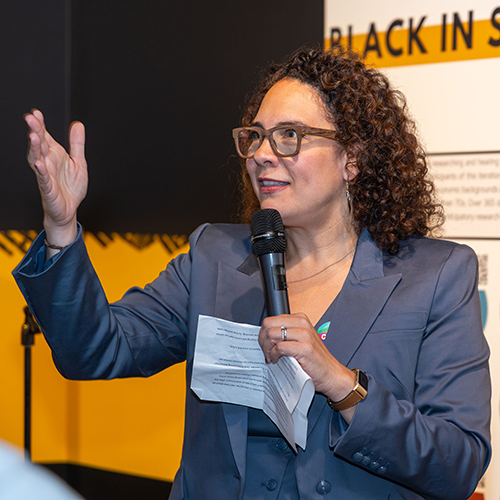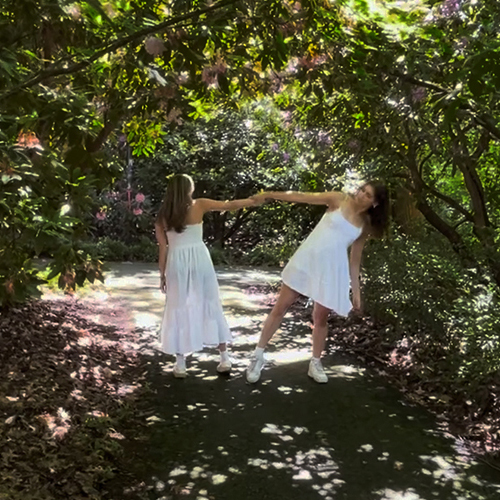The halls were buzzing at Valley View Elementary School in Toppenish, Washington. The word was out: University of Washington students would be visiting for the next few days.
Two dozen UW music students had spent a day teaching in the school in October; now a smaller group would be visiting for nearly a week. Both groups have been part of Music Alive! in the Yakima Valley, a UW School of Music program that ties UW music courses to school visits in the Yakima Valley.
“You can see the excitement in the children’s faces,” says Patricia Campbell, professor of music education and director of the Music Alive! program. “The UW students say they feel like TV stars because the children are so excited when they come into the classroom.”

The program revives a music program offered in the late 1990s, inspired by a phone call from a teacher on the Yakama Reservation. The teacher wondered whether UW students could visit her school and perform; Campbell offered to have them visit classrooms and teach songs as well. That program was funded by the School of Music and the Office of Minority Affairs for three years. The current offering is funded for 2005-06 by the same units plus the College of Arts and Sciences.
Valley View Elementary, at the edge of the Yakama Reservation, is the main focus of the current program. The student body is 98 percent Mexican American, with Spanish as their first language. Visiting the school, says Campbell, provides an educational experience that cannot be replicated in a UW classroom.
“This program is a chance to bridge differences through music,” says Campbell. “Music education has plenty of theory and lots of musical analysis, but to understand how musical cultures live requires going into the living cultures and communities where the music is made, all the way over to the fifth graders who pick up their fiddles to play in their uncles’ mariachi band and the five year olds who play singing games.”
The October visit was part of a music education course that emphasized the curricular integration of music into social studies and language arts classes. The more recent visit, in January, was part of an ethnomusicology course focused on the music of different cultures.
Graduate student Amanda Soto, teaching assistant for both courses, made six visits to Valley View Elementary before the first UW class arrived. Raised in south Texas, she had attended schools that were 99 percent Hispanic, so she was familiar with cultural issues that might arise. She worked briefly with each elementary class to get the students ready for the UW students’ visit.
“We did some rhythm activities and standard Spanish tunes,” she says. “They already knew many of them. They love these songs.”
This program is a chance to bridge differences through music.... To understand how musical cultures live requires going into the living cultures and communities where the music is made....
Even with Soto’s preparation, facing the youngsters proved daunting for many UW students. “I was totally nervous the first time I went into the classroom,” admits Paiyu Chiu, a doctoral student in piano performance who enrolled in both courses. “You always feel insecure going into a field you don’t know. It was challenging. I told myself it was okay to make mistakes. I’m still learning. But the students loved us. The power of music can be overwhelming.”
The UW students taught in teams of three. Clare Krier, a music education major, was on Chiu’s team during the January visit. Krier plays trumpet in the Husky Marching Band and hopes to be a school band director someday. But leading classes at Valley View Elementary School—that was something different.
“The first class was the most nerve-wracking,” says Krier. “Things go wrong because you haven’t worked out the kinks yet. If you spend too much time on one thing, the students get bored and start fading. But we improved quickly. I remember the second class being so much better than the first.”
At week’s end, the Valley View students performed some of the songs they had learned in class. The UW students realized they had learned a few things as well. “Elementary school kids are fun, so sometimes it feels like you’re just playing instead of making music,” says Krier. “But you are making music. The kids have so much energy. The challenge is to match that.”
As part of the ethnomusicology course, the UW students also visited the Yakama Tribal School. The high school students played pow wow drums for the visitors, who in turn performed some classical and jazz pieces. The two groups then chatted informally.
“That was one of my favorite parts of the trip because it was something I wouldn’t normally be invited to participate in,” says Krier. “The students there were very proud of their own traditions. They got to share something with us, and we got to share with them. It was cool.”
Homestays provided another opportunity for sharing. During the January visit, students stayed in local homes. “We liked the idea that the students would go home in the evening and be with a family,” says Campbell. “Even though the residency was short-term, it was the sort of cultural immersion that can shift attitudes. The power of a single experience can make the difference.”
Chiu and several classmates stayed with a Mexican-American family with three children. “I was a little shy at first, but they were really open and it quickly felt comfortable,” says Chiu. “The mother talked with us about her background and her family’s history. And she was a really good cook. That was my first experience with real Mexican food, not the type you get in a restaurant.”
All these experiences added up to a memorable trip. Students had to rearrange schedules to participate, in some cases missing several classes and music rehearsals, yet all agreed it had been worth the effort.
Chiu, who offers private piano lessons to 20 students, had to rearrange many lessons to go on the trip. “It was still worth it,” she says. “It’s made me think about music differently. I’ve started to think about how to make music more fun for my students. I’m planning to explore different sounds, and the music of different cultures, in my lessons. I think I can make my students enjoy music more.”
Campbell and Soto are planning a final trip to Toppenish in May. This one will be all play and no work. They, along with interested students, will attend the local community’s huge Cinco de Mayo celebration—a fitting coda to a year of cultural exploration.
“Music, like all of the arts, is an opportunity to be part of making something beautiful and communal,” says Campbell. “This will be our chance to celebrate
that.”
More Stories

Democracy by the Numbers
Mathematics and Democracy, an undergraduate mathematics course, explores the role of math in many aspects of democracy, from elections to proportional representation.

Interrupting Privilege Starts with Listening
Personal stories are integral to Interrupting Privilege, a UW program that leans into difficult intergenerational discussions about race and privilege.

Dancing Across Campus
For the dance course "Activating Space," students danced in public spaces across the University of Washington's Seattle campus this spring.